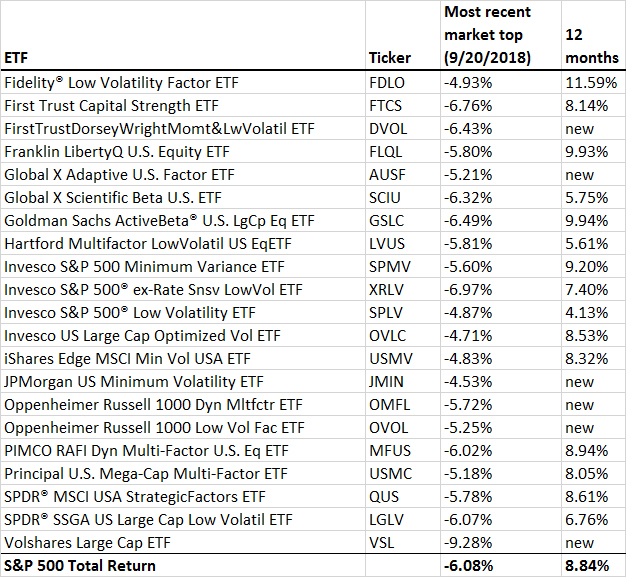Low-Volatility ETFs Are Doing Their Job
These funds made a stomach-churning week easier to swallow


Many low-volatility ETFs are actually doing what they promised: delivering smaller losses in down markets.
The idea behind low-vol funds: Buy stocks with the lowest up-and-down moves. In theory, these stocks will suffer less in a down market.
Two important corollaries to the theory:

Sign up for Kiplinger’s Free E-Newsletters
Profit and prosper with the best of expert advice on investing, taxes, retirement, personal finance and more - straight to your e-mail.
Profit and prosper with the best of expert advice - straight to your e-mail.
- They also will tend to rise less in up markets. Risk and return are joined at the hip: If you want lower volatility when the market is down, you’ll get it when the market is up, too.
- They still will fall in a down market. These are, after all, stock ETFs, and when the broad market falls, they will swoon along with it. Don’t buy one of these if you can’t stand to see your investment fall in value at all.
Because these funds are less volatile, you’re less likely to panic and sell in a downturn. And, because your losses will be smaller than a garden-variety ETF, you should return to profitability faster than an ETF that simply tracks the Standard & Poor’s 500-stock index.
Special mention should be made of these three low-vol ETFs:
- Fidelity Low Volatility Factor ETF (FDLO, $31.91) has fallen 4.93% since the S&P 500’s Sept. 20 high, while the index has tumbled 6.08%. The past 12 months the fund is up 11.59%, vs. 8.84% for the S&P 500.
- Franklin LibertyQ U.S. Equity ETF (FLQL, $29.86), down 5.80% since the market high and 9.93% for the past 12 months.
- Invesco S&P 500 Minimum Variance ETF (SPMV, $29.02), down 5.60% since the market high and 9.20% for the past 12 months.
Look carefully to see how the ETFs construct their portfolios. Invesco S&P 500 Low Volatility ETF (SPLV, $47.35), for example, simply invests in the 100 least volatile S&P 500 stocks and gives the least volatile stocks the highest weighting. The fund reconstitutes its holdings every quarter.
iShares Edge MSCI Min Vol USA ETF (USMV, $54.11) uses the MSCI USA Index, a somewhat more comprehensive index that includes mid-cap names. The fund picks the least volatile stocks within each industry sector, ensuring greater diversification.
Here’s the rundown on large-company blend low-volatility ETFs and how they have performed as of Oct. 11. Dividends and gains are reinvested. Data via Morningstar.

Get Kiplinger Today newsletter — free
Profit and prosper with the best of Kiplinger's advice on investing, taxes, retirement, personal finance and much more. Delivered daily. Enter your email in the box and click Sign Me Up.

-
 6 Stunning Waterfront Homes for Sale Around the US
6 Stunning Waterfront Homes for Sale Around the USFrom private peninsulas to lakes, bayous and beyond, Kiplinger's "Listed" series brings you another selection of dream homes for sale on the waterfront.
By Charlotte Gorbold Published
-
 Six Reasons to Disinherit Someone and How to Do It
Six Reasons to Disinherit Someone and How to Do ItWhether you're navigating a second marriage, dealing with an estranged relative or leaving your assets to charity, there are reasons to disinherit someone. Here's how.
By Donna LeValley Published
-
 Stock Market Today: Stocks Surge to Close a Volatile Week
Stock Market Today: Stocks Surge to Close a Volatile WeekIt was another day with a week's worth of both news and price action, but it ended on a strongly positive note.
By David Dittman Published
-
 Stock Market Today: Uncertainty Proliferates: Dow Loses 1,014 Points
Stock Market Today: Uncertainty Proliferates: Dow Loses 1,014 PointsWeaker-than-expected consumer inflation data wasn't enough to stabilize sentiment during another volatile day for financial markets.
By David Dittman Published
-
 Stock Market Today: Tariff Pause Triggers 3,000-Point Dow Rally
Stock Market Today: Tariff Pause Triggers 3,000-Point Dow RallyThe bond market is sending concerning signals as the Trump administration executes its rapid reordering of global trade relationships.
By David Dittman Published
-
 Stock Market Today: Tariff Talks Drive Another Up-and-Down Day
Stock Market Today: Tariff Talks Drive Another Up-and-Down DayTrade war negotiations are happening, but the "fear gauge" is gyrating, and investors, traders and speculators are still searching for signs of a bottom.
By David Dittman Published
-
 Stock Market Today: Trump Pushes Dow Into 2,600-Point Swing
Stock Market Today: Trump Pushes Dow Into 2,600-Point SwingTariffs and trade war weigh on prices across global financial markets, with little light at the end of the tunnel.
By David Dittman Published
-
 Stock Market Today: Dow Drops Another 2,231 Points to Hit a Correction
Stock Market Today: Dow Drops Another 2,231 Points to Hit a CorrectionThe Nasdaq Composite, meanwhile, entered a new bear market with its latest slide.
By Karee Venema Published
-
 Stock Market Today: Dow Dives 1,679 Points on Trump Tariff Shock
Stock Market Today: Dow Dives 1,679 Points on Trump Tariff ShockU.S. stocks lost roughly $3.1 trillion in market cap on Thursday – the biggest one-day decline since the start of the COVID-19 pandemic in March 2020.
By Karee Venema Published
-
 Stock Market Today: It's the Old Up-Down Again on Liberation Day
Stock Market Today: It's the Old Up-Down Again on Liberation DayMarkets look forward to what comes with the reordering of 80-year-old global trade relationships.
By David Dittman Published